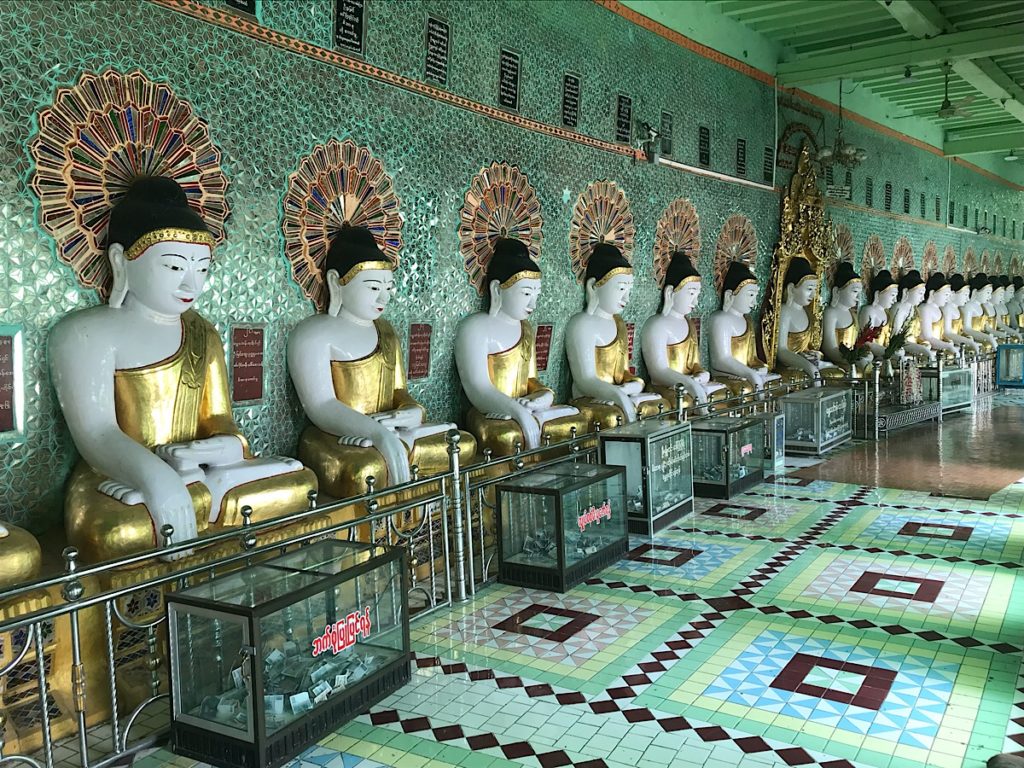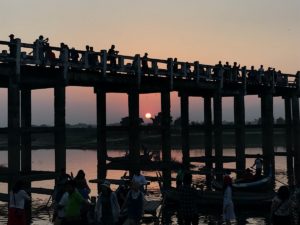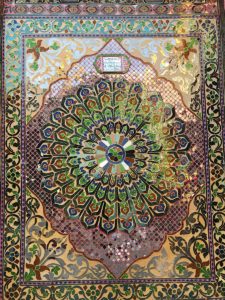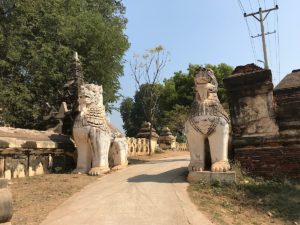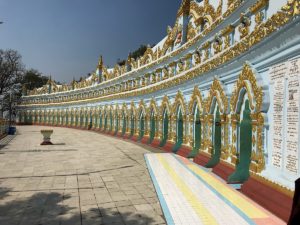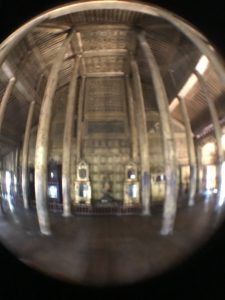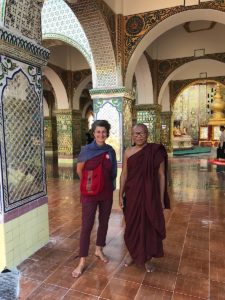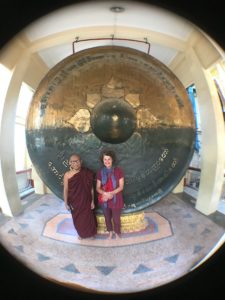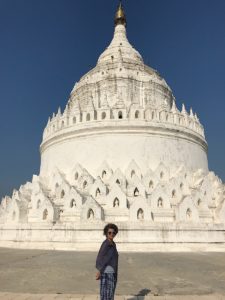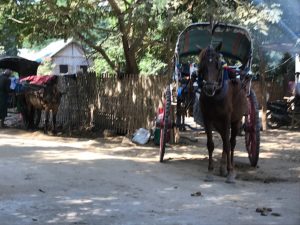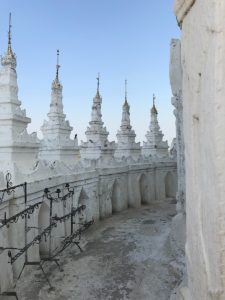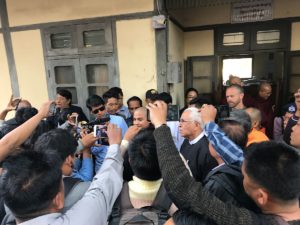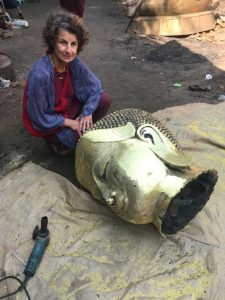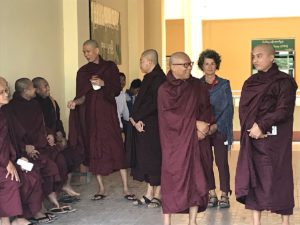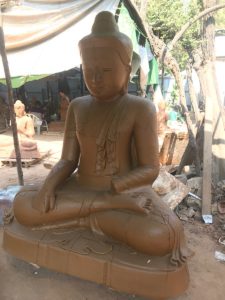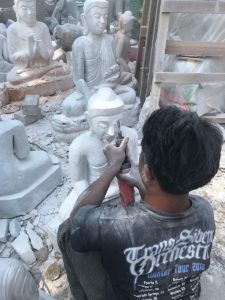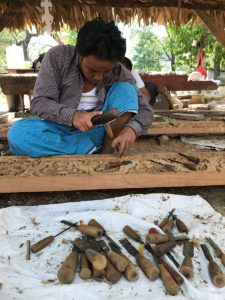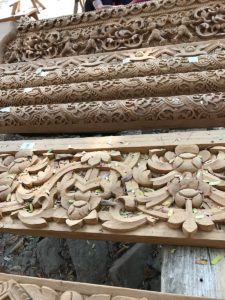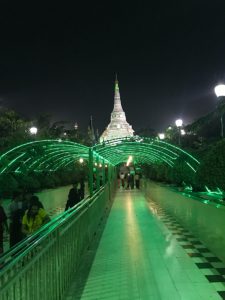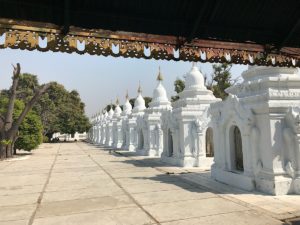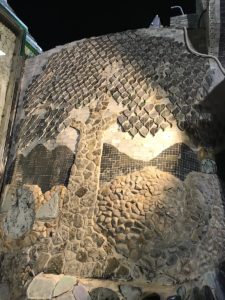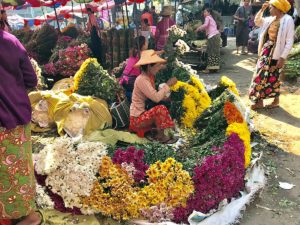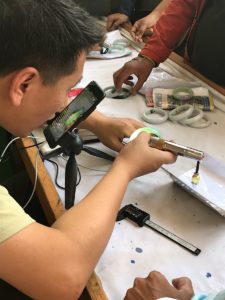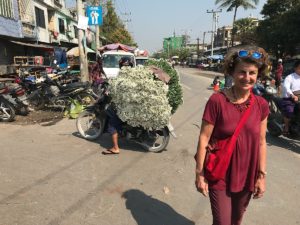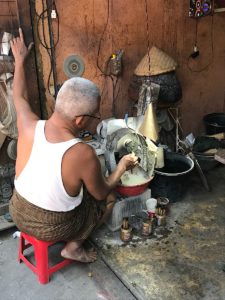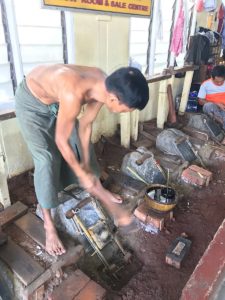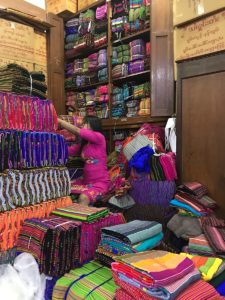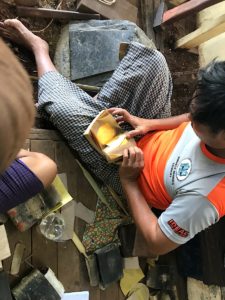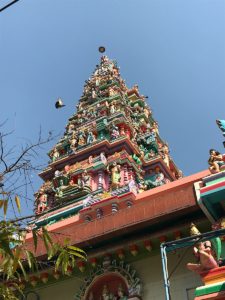Day 1
Arriviamo a Mandalay con un bus Vip, configurazione sedili 2+1 11 file, sedili reclinabili, la compagnia dei bus JJ sembra sia la migliore. Partenza da Inle la sera alle 21.00 stimato arrivo alle 5.00. Abbiamo prenotato un albergo con Agoda. Il sistema ha spesso offerte ultimo minuto e troviamo un bel albergo per 15000 kyat. Attenzione però perché a differenza di booking.com anticipano il pagamento e alla fine noi abbiamo pagat 2 volte (ns errore) Avvertiamo che arriveremo presto e dicono no problem.
La strada non è lunga circa 250km ma tra fermate per bagni e fermate per traffico il viaggio è lungo. Arriviamo in anticipo verso le 4.00 cambio di autobus, fino alla stazione. Una serie di tuc tuc sono lì ad aspettare, lasciamo perdere grab e prendiamo un tuc tuc per l’ albergo. All’albergo, tutto chiuso, da dentro ci vedono quindi aprono e ci danno la camera, ci buttiamo giù sui letti duri come un mattone e dormiamo qualche ora. L’hotel è il New Nylon 20$
Mandalay
Day 1
We arrive in Mandalay with a Vip bus, configuration seats 2 + 1 11 rows, reclining seats, the bus company JJ seems to be the best. Departure from Inle in the evening at 21.00 estimated arrival at 5.00. We booked a hotel with Agoda. The system often has last minute offers and we find a nice hotel for 15000 kyat. Be careful though because they pay the hotel ahead and as we didn’t know we ended up paying twice . We le5 the hotel know that we will arrive early and they say’ no problem’.
The road is only about 250km long but between stops for bathrooms and stops for traffic the journey is long. We arrive early morning around 4.00 and change bus. A series of tuc tuc are there to wait for customers. The hotel is locked closed, they see us and open and give us the room, we sleep a few hours. The hotel is the New Nylon 20 $
Day 2
La colazione è abbondantissima con riso, noodle (spaghettini), uova pane, frittelle e chi più ne ha più ne metta. Non siamo ancora abituati a tali. pranzi mattinieri … Oggi ci dobbiamo incontrare con Ashin Kovida, un monaco amico di una nostra amica che ci porterà in giro per la città. Questa volta dovremmo avere un po’ più di contatto con la realtà locale ed è questo che ci interessa più di monumenti e artigiani. Le cose da vedere in città sono abbastanza sparse quindi la soluzione classica di prendere un taxi o tuc tuc e farsi portare in giro tutto il giorno ,costo circa 50.000 Kyatt risulta pratica. Affittare un motorino sembra essere illegale . Facciamo un giro abbastanza classico…
Day 2
Breakfast is abundant with rice, noodle, eggs, bread, pancakes and so on!. We are not yet used to these early morning “lunch” … Today we have to meet with Ashin Kovida, a monk friend of a friend of ours who will take us around the city. This time we should have a little more contact with the local reality and this is what interests us more than monuments and artisans. Things to see in the city are quite scattered so we opt for the classic solution to take a taxi or tuc tuc and be drive around all day, (cost about 50,000 Kyatt ) . Renting a scooter seems to be illegal. Let’s do a fairly classic Tour …
Visitiamo la zona di Inwa , periferia di Mandalay e una delle antiche capitali. Normalmente si viene portati al molo e con la barca si attraversa il fiume e poi si sale su calesse per andare alle rovine, noi facciamo un giro sul ponte e andiamo diretti a templi e rovine con l’auto. Per accedere alla zona archeologica bisogna pagare 10.000k . Tenete il biglietto che vi verrà chiesto in tutti i posti dove andate, un altro biglietto da 5000k che vi verrà chiesto di pagare, è per un altra area archeologica. In teoria potete acquistare biglietti singoli per le diverse cose ma non viene pubblicizzato e non sono mai riuscito a capire come si faccia.
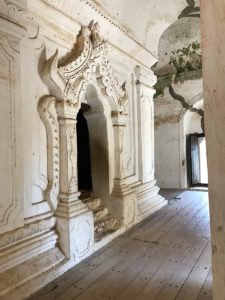 Mae Nu Oak Kyaung è un tempio piuttosto importante per la sua storia e come tutti i monumenti e templi, all’entrata ha una miriade di bancarelle che vendono souvenir ma anche fiori , ombrellini di carta e quadratini con foglia d’oro da appiccicare su i Buddha come offerte.
Mae Nu Oak Kyaung è un tempio piuttosto importante per la sua storia e come tutti i monumenti e templi, all’entrata ha una miriade di bancarelle che vendono souvenir ma anche fiori , ombrellini di carta e quadratini con foglia d’oro da appiccicare su i Buddha come offerte.
Poi andiamo al Bagaya Monastery, un monastero in legno con monaci che si fanno fotografare mentre mangiano o insegnano, una sosta che normalmente si fa il mattino dato che i monaci mangiano colazione e poi pranzo prima di mezzogiorno e poi niente fino a giorno dopo (anche questo in teoria dato che spesso vediamo monaci mangiare fuori orario, la dieta del monaco con nostra sorpresa non è vegetariana come pensavamo, maiale pollo pesce sono comuni). Noi non siamo lì per assistere al pranzo, ma da persone che ci sono state, sembra sia un po’ una visita allo zoo dove tutti armati di macchine fotografiche e telefonini si spintonano per catturare la scena.
Mangiamo qualcosa e via per Sagaing hill, prendiamo il ponte vecchio costruito durante la dominazione inglese, anche il treno passa su questo ponte . Il nuovo ponte costruito da 5 o 6 anni è più a nord. Raggiungiamo la collina piena di pagode, con anche una struttura semicircolare con 108 Buddha molto suggestiva e ben mantenuta, probabilmente un orrore per archeologi , qua se qualcosa qui si rompe, lo si aggiusta senza pensarci su troppo, con quello che si ha. Placche con iscrizioni mostrano i nomi di chi ha ontribuito alla restaurazione, molti europei e con un po’ di sorpresa molti canadesi. Invece che le scale infinite dalla piana prendiamo una strada (in teoria a senso unico che ci porta fino in cima). Tutti i templi con folle di fedeli che danno rintocchi a campane, si prostrano al suolo, infilano soldi in tutti gli altari, si mettono in alcune zone specifiche dov’è secondo le credenze, stando lì ed esprimendo un desiderio questo si avvererà. In molti templi compilano anche un certificato che attesta che sei stato lì e quanto hai donato. Io pensavo fosse una ricevuta fiscale per detrazioni:).
We visit the Inwa area, on the outskirts of Mandalay and one of the ancient capitals. Normally you are taken to the pier and with the boat you cross the river and then you take a horse carriage to go to the ruins, we take a ride on the bridge and go direct to temples and ruins with the car. To access the archaeological area you must pay 10,000k. Keep the ticket you will be asked of if in all the places you go. Another 5000k ticket that you will be asked to pay, is for another archaeological area. In theory, you can buy single tickets for different things but it is not advertised and I have never been able to understand how to do it.
Mae Nu Oak Kyaung is a rather important temple for its history and like all the monuments and temples, at the entrance has a tons of booth selling souvenirs but also flowers, paper umbrellas and squares with gold leaf to stick on the Buddha as offers.
Then we go to the Bagaya Monastery, a monastery in wood with monks who are photographed while they eat or teach, a stop that normally takes place in the morning as the monks eat breakfast and then lunch before noon and then nothing until a day later (also this is theory since we often see monks eating out of that schedule, the monk’s diet to our surprise is not as vegetarian as we thought, pork chicken fish are common). We are not there to attend the lunch, but from people who have been there, it seems a bit ‘a visit to the zoo’where everyone armed with cameras and mobile phones jostle to capture the scene.
We eat something and go to Sagaing hill, take the old bridge built during the English domination, the train still use this bridge. The new bridge built 5 or 6 years is further north. We reach the hill full of pagodas, with a semicircular structure with 108 Buddhas very suggestive and well maintained, probably a horror for archaeologists, here if something breaks you adjust with what you have without thinking too much. Plates with inscriptions show the names of those who have contributed to the restoration, many Europeans and with a little surprise many Canadians. Instead of the endless stairs from the plain we take a road (in theory one way that takes us to the top).
All the temples with crowds of worshipers who strike the bells, prostrate themselves on the ground, offer money on all the altars, put themselves in some specific areas where for example, according to the beliefs, standing there and expressing a wish, will make the wish come true. In many temples on request they also prepare a certificate attesting that you have been there and how much you have donated. I thought it was a tax receipt for deductions 🙂
Un tempo i soldi dei biglietti di ingresso finivano nelle mani dei militari, adesso tutti i soldi donati alla pagoda sono gestiti da un “trustee/fiduciaria” il cui compito è di amministrarli, in realtà sembra esserci un mangia mangia , tutto il mondo è paese e i risparmi che i poveri fedeli donano non sempre vengono usati non diciamo a fin di bene, ma almeno a ristrutturare e mantenere i templi. In generale una donazione ad un monaco finisce per essere usata in modo migliore di quelle date ad un tempio o pagoda. Parlando con il Monaco riusciamo a capire un po’ di cose come ad esempio i caselli su autostrade sono gestiti da chi sta costruendo la strada è così spera di recuperare i soldi che mette dentro, le tasse sono molto basse, il concetto di tassa è un concetto che non è molto capito dalla popolazione, la gente si aiuta uno con altro, e persone benestanti fanno grosse offerte a templi e associazioni. Le infrastrutture sono limitate e mi sembra di capire che per la popolazione esiste un solo grosso ospedale pubblico a Yangon ma nelle altre città c’è poco o niente, solo strutture private dove stare costa 25$ al giorno, prezzo astronomico per maggior parte della popolazione. Per questo motivo il nostro amico monaco , con l’aiuto di una coppia Svizzera vuole espandere un centro di assistenza che ha creato in Mandalay. La clinica offre servizi di assistenza medica gratuita basandosi su offerte. Il nuovo progetto di espansione sarà poco fuori città con più strutture, ora è in costruzione, domani andremo anche a visitare il terreno dove stanno iniziando la costruzione. Mi propongo di aiutare con costruzione del sito web, se qualcuno vuole aiutare è benvenuto, scrivetemi, il mio web design è un po’ arrugginito. La clinica sarà concentrata su educazione, servizio dentale (che a causa del betel qui è critico) . Sono anche interessati a fare formazione ai dentisti locali che offrono il loro tempo gratuitamente per la cura dei pazienti. Quindi se volete aiutare siete probabilmente benvenuti.
Tra chiacchiere e informazioni la gita continua.
In the past the money for entrance tickets ended up in the hands of the military, now all the money donated to the pagoda is managed by a “trustee” whose job is to administer them, in reality there seems to be a bit of corruptions and money disappear and not use for fixing temples or maybe something even more useful helping peoples. In general, a donation to a monk ends up being used better than those given to a temple or pagoda. Speaking with the monk we can understand a few things such as the toll booths on motorways being managed by those who are building the road so they recover the money they puts in, the taxes are very low, the concept of tax is a concept that is not very understood by the population, people help one another, and wealthy people make big offers to temples and associations. The infrastructures are limited and I understand that there is only one big public hospital in Yangon for the population, but there is little or nothing in the other cities, only private facilities where it costs 25 $ a day, astronomical price for most of the population . For this reason our monk friend , with the help of a Swiss couple, wants to expand an assistance center he created in Mandalay. The clinic offers free medical services and is running on offers. The new expansion project will be just outside the city with more structures, now it is under construction, tomorrow we will also go to visit the land where construction is beginning.
I offer to help with building the website, if anyone wants to help please email me, my web design is a bit rusty. The clinic will be focused on education, dental service (which due to the betel chewing here is critical). They are also interested in training local dentists who offer their free time for patient care. So if you want to help you are probably welcome.
Between chats and information the tour continues.
Si continua per Mingun Paya, progetto mai terminato della pagoda più grande del mondo con relativi leoni che dovevano anche loro essere i più grandi in realtà adesso si possono vedere solo i posteriori dei leoni mentre il fronte è collassato. La grande pagoda è un ammasso di mattoni, forse potremmo evitare la strada….Guardando la quantità di mattoni si può immaginare che la zone circostanti siano state pesantemente disboscate per cuocere tutti quei mattoni.
Poi più avanti andiamo a vedere e a suonare la campana più grande al mondo, ancora appesa e funzionate . La distinzione va fatta perché esiste una campana più grande al Cremlino, ma è rotta e giacie al suolo.questa invece è appesa e veramente gigante e ci si può anche andare dentro sperando che nessuno la suoni quando si è dentro. Per i buddisti le campane sono molto importanti e spesso sono fuori dalle pagode . I fedeli fanno 3 rintocchi o a volte in numero legato a quanti anni copiono, normalmente sono cose legate alla numerlogia Buddhista ( numeri importanti sono dispari, 3, 7, 9 relativi multipli etc. importante anche il 108.Vicino alle campane ci sono dei battachi in legno, suonare la campana serve per annunciare che qualcuno ha fatto una buona azione cosi tutti possono rallegrasi per questo.
Poi la cosa più interessante di Mingun ( nome della zona) la stupa buddista Hsinbyume Paya. Una struttura completamente differente da quello che abbiamo visto finora ed affascinate architettura.
Il sole scende e quindi siamo in tempo per classica passeggiata sul ponte , iconica immagine di Mandalay, U Bein bridge. il ponte che ha circa 100 anni ha pilastri di teak oscilla un po’ ma sembra resistere, pezzi del ponte sono stati ricostruiti in cemento e stanno disfandosi, in questo periodo il fiume è abbastanza basso e sotto si può passare con calesse e macchine su una sardina rialzata.
Nella stagione dei monsoni il ponte è più utile e gran parte dei terreni adiacenti , coltivati in inverno sono sommersi., miriadi di turisti fanno fotografie e a volte pagano monaci per passeggiare avanti e indietro e avere la classica foto cartolina. Altra attività è salire su piccole barchette che ricordano un po’ Venezia , che si spostano da un lato all’altro portando turisti locali e stranieri per catturare dal basso il ponte con un po’ di acqua sotto. . Qualche giorno dopo andremo su un altro ponte che attraversa uno stagno/fiume , una piccola versione dell’U Bein, forse un altra occasione per foto al tramonto magari meno scontate e probabilmente senza orde di persone. Il ponte è all’uscita della Chan Thaya Pagoda.
Fine della giornata, hotel, doccia e, ristorante e poi a letto.
We continue to Mingun Paya, the never ended project of the largest pagoda in the world with its lions that also had to be the largest, in reality now you can see only the hinds of the lions while the front has collapsed. The big pagoda is a pile of bricks, maybe we could have avoided the visit… Looking at the amount of bricks you can imagine that the surrounding areas have been heavily deforested to fire all those bricks.
Then later we go to see and play the biggest bell in the world, still hanging and working. A note must be made because there is a bigger bell in the Kremlin, but it is broken and lies on the ground. But this is hanging and really giant and you can even go inside hoping that no one will play it when you are inside. For the Buddhists the bells are very important and are often out of the pagodas. The devotees make three strokes or sometimes in number related to how old they are , normally they are things related to Buddhist numerology (important numbers are odd, 3, 7, 9 relative multiples etc. also important 108. Near the bells there are wood sticks , ringing the bell is used to announce that someone has done a good deed so everyone can rejoice for it.
Then we go and visit the highlight of the day, the Buddhist stupa Hsinbyume Paya. The architecture is absolutely different from what we have seen so far.
The sun goes down and so we are on time for a classic walk on the bridge, the iconic image of Mandalay, U Bein bridge. the bridge that has about 100 years old has teak pillars, it rocks a little but seems to resist, pieces of the bridge have been rebuilt in cement and are already falling apart , the wood builders did a better job. In this period the river is quite low and below can be passed with buggy and cars on a raised path. In the monsoon season the bridge is more useful and most of the adjacent land, that during winter are cultivated in summer are submerged. Tons of tourists take pictures and sometimes pay monks to wander back and forth and have the classic picture postcard. Another activity is to embark on small boats that are reminiscent of Venice, crossing the river where possible, bringing local and foreign tourists to capture the bridge from below with a little water underneath. . A few days later we will go on another bridge that crosses a pond / river, a small version of the U Bein, perhaps another occasion for sunset photos, perhaps less obvious and probably without hordes of people. The bridge is at the exit of Chan Thaya Pagoda.
End of the day, hotel, shower and, restaurant and then in bed.
Day 3
Buddha ricoperto di foglie d’oro. (Mahamuni Pagoda)La statua con tanto di telecamera con schermo che mostra il Buddha è molto popolare e tutti i fedeli comperano foglietti con foglio d’oro da applicare alla statua, ci sono foto della statua di vari periodi e si vede come con il tempo sia cresciuta, dato che le foglie d’oro sono applicate spesso nello stesso posto si vedono piccole montagnette su tutto il corpo. Come in alcuni altre pagode alle donne non e’ permesso avvicinarsi alla statua. Abbiamo chiesto al nostro amico Monaco il motivo ma apparentemente è una tradizione senza alcun fondamento e non è applicata in tutte le pagode.
Ci viene chiesto di partecipare ad una udienza per un processo che un monaco amico di Kovida deve sostenere per avere criticato il regime militare. La mattina la passiamo quindi in corte in supporto di questa causa, per chi è interessato a fatti politici di questo paese di cui poco si riesce a sapere scriverò un altro resoconto.
L’artigianato a Mandalay è una parte importante dell’economia. Vogliamo quindi visitare i laboratori di scultori di marmo, fonditori di bronzo e la famosa produzione di foglie d’oro che sono così comuni offerte nei templi.
Fonderie, il soggetto principale è come al solito immagini di Buddha. Il processo è quello della cera persa, la statua viene fatta in creta mista a paglia, nelle strutture più grandi viene anche armata con filo di ferro o armatura del calcestruzzo. Poi viene ricoperta da fogli di cera poi un altro strato di creta e paglia, poi la cera viene sciolta e il bronzo viene colato. La cera recuperata viene riscaldata e passata in rulli per produrre altri fogli il cui spessore varia in base alle dimensioni della statua. Segue un lungo lavoro di pulitura e lucidatura. La fonderia che visitiamo ha realizzato anche grandi opere ad esempio una che è stata spedita in Francia, data la dimensione e non entrando in un container, è stata trasportata in 4 pezzi, e la persona con cui parliamo ha fatto parte del team che ha costruito e riassemblato la statua a nord di Montpellier. Vediamo un libro che racconta la storia, molto interessante. I clienti delle fonderie sono spesso devoti che comperano per i templi.
Scultori del marmo. Questo quartiere è avvolto in una nuvola di polvere, ogni negozio ha giganti blocchi di marmo bianco da cui abili scultori ricavano principalmente Buddha . Ovunque statue spesso con testa incompiuta. Probabilmente vengono terminati su commissione. Alcune sculture sono veramente impressionanti per dimensioni ed alcune così lucidate che sembrano di porcellana bianca. Vediamo spesso anche alberghi che all’ingresso hanno statue e bronzi o anche sculture in legno.
Day 3
First morning visit, Buddha covered with golden leaves (Mahamuni Pagoda) .The statue with a lots of camera with screen showing the Buddha while being covered in gold is very popular and all the devotes, buy sheets with gold leaf to be applied to the statue, there are pictures of the statue of various periods and you can see how with the time it has grown, given that the golden leaves are often applied in the same place small mounts are seen all over the body. As in some other pagodas, women are not allowed to approach the statue. We asked our friend for the reason but apparently it is a tradition without any foundation and it is not applied in all the pagodas.
We are asked to attend a hearing for a trial that a monk , ,friend of Kovida, has to attend being accused for criticizing the military regime. We spend the morning in court in support of this cause, for those interested in political events in this country of which little I was able to know I will write another report.
The craftsmanship in Mandalay is an important part of the economy. We therefore want to visit the workshops of marble sculptors, bronze founders and the famous production of gold leaves that are so common offered in temples.
Foundries, the main subject is as usual images of Buddha. The process is that of using wax, the statue is made of clay mixed with straw, in the larger structures it is also reinforced with iron wire or concrete reinforcement. Then it is covered with sheets of wax and then another layer of clay and straw, then the wax is melted and the bronze is poured in its place. The recovered wax is heated and passed into rolls to produce other sheets whose thickness varies according to the size of the statue. A long cleaning and polishing job follows. The foundry we visit has also made huge jobs such as one that was shipped to France, and given the size and not entering a container, was transported in 4 pieces, and the person we talk to , was part of the team that built and reassembled the statue north of Montpellier. We see a book that tells the story, very interesting. Foundry clients are often devotees who shop for temples.
Marble sculptors. This neighborhood is wrapped in a cloud of dust, each store has giant blocks of white marble from which skilled sculptors mainly draw Buddha. Everywhere you see statues often with an unfinished head. They are probably finished on commission. Some sculptures are really impressive in size and some are so polished that they look like white porcelain. We also often see hotels that have statues and bronzes at the entrance or even wooden sculptures.
Finito con gli artigiani abbiamo da visitare ancora tre cose:
Prima cosa passiamo a vedere dove il nostro amico prevede di costruire la nuova clinica, il terreno e alle porte di Mandalay, un progetto ambizioso, vi terremo aggiornati su come va. Poi via per :
Mandalay Hill, anche in questo caso strada ci porta vicino alla vetta e un ascensore ci fa arrivare in cima , ottimo specialmente con temperature attorno ai 34 gradi. Vista 360 gradi con molti diversi templi pagode e altro, molto turismo locale e un lavoro di mosaici di specchi unico. Un po’ di artigiani tagliano tutte le sagome e altri le installano, penso che questi templi siano come la fabbrica del duomo, mai finiti.
Atumashi Kyaung teak temple, incredibile edificio in legno completamente scolpito. Il tempo ha lasciato le sue tracce quindi con l’aiuto di una cooperazione internazionale vengono ricostruite le parti mancanti e restaurate quelle danneggiate . Vediamo all’opera qualcuno con motosega nellacostruzione di alcuni incastri per i pilastri e una schiera di artigiani locali intaglia invece i profili dei tetti, vicini agli originali si distinguono unicamente perché di colore è diverso e il fatto che non sono usurati. Interessanti mobili per tenere i paramenti dei monaci sono in mostra all’ interno. Vicinissimo passiamo a visitare
Kuthodaw Pagoda (Burmese: ကုသိုလ်တော်ဘုရား , formalmente Mahalawka Marazein è il più grande libro al mondo, nel senso che ci sono un infinita’ di piccole stupas allineate con placche di marmo con iscrizioni che sono praticamente le pagine di un unico libro. Per leggere il grande libro nell’ultima riunione che hanno avuto i monaci ci hanno impiegato sei mesi!
Saltiamo la visita al “palazzo” molto esteso e con poco da vedere,anche perché per questo serve il biglietto “zona archeologica”
Rientriamo in albergo per una veloce doccia e tramonto dal tetto dell’albergo. Poi dopo il tramonto usciamo direzione tempio di Giada. Di notte illuminato è una meraviglia, non è grandissimo ne’ con architettura particolare ma è interamente ricoperto di giada, sulla punta ci sono anche sottili tagli di giada retroilluminato e come un faro illuminano di verde profondo il cielo. Blocchi di ogni dimensioni emergono e ci sono mosaici su tutte le pareti. Ai 4 angoli 4 Buddha finemente scolpiti e lucidati sono meta dei devoti. Tunnels di led Verdi portano alla pagoda e tunnel girano anche intorno ad essa. Molti giovani Burmesi si aggirano scattando foto , selfies e portando offerte.Non si paga ingresso, è una meta poco nota e poco visitata anche perché non vicino al centro. La struttura ha solo una decina di anni ed è stato costruita grazie alla donazione da parte delle cave del nord del paese. 21.857458, 96.02024, Jade Pagoda ကျောက်စိမ်းဘုရား
Finished with the artisans we still have three things to visit:
First we go to see where our friend plans to build the new clinic, the land is at the entrance of Mandalay, an ambitious project, we will keep you updated on how it goes. Then off to:
Mandalay Hill, also in this case the car takes us near the summit and a lift bring us to the top, especially comfortable, with temperatures around 34 degrees. View 360 degrees with many different pagodas temples and more, lots of local tourism and a unique mosaic work of mirrors. Some artisans cut all the shapes and others install them, I think these temples are like the dome of Milano, a never ending work.
Atumashi Kyaung teak temple, se one stop, amazing fully carved wooden temple. Time has left its traces, so with the help of international cooperation, the missing parts are rebuilt and the damaged parts restored. We see someone working with a chainsaw in the construction of some joints for the pillars and an array of local craftsmen carves instead the profiles of the roofs, the originals are distinguishable only because the colour of the wood is different and they are not yet worn down . Interesting furniture to keep the monks’ vestments are exhibited inside. Near there
Kuthodaw Pagoda (Burmese: ကုသိုလ်တော် ဘုရား, formally Mahalawka Marazein is the largest book in the world, meaning that there are an infinite number of small stupas lined with marble plaques with inscriptions that are practically the pages of a single book. At the last ‘convention’ of monks , a few years ago,the reading of the books took 6 months!
We skip the visit to the “palace” very extensive area, with little to see, also because we would need an extra ticket for “archaeological area”
We return to the hotel for a quick shower and sunset from the roof of the hotel. Then after sunset we go out to the temple of Jade. At night it is a marveloussight, it is not very big nor with particular architecture but it is entirely covered with jade, on the tip there are also thin jade cuts backlit and like a lighthouse they illuminate the sky with deep green. Blocks of every size emerge and there are mosaics on all the walls.
At the 4 corners , 4 finely sculpted and polished Buddhas are a destination for devotees. Green LED tunnels lead to the pagoda and tunnels also run around it. Many young Burmese hang out here taking pictures, selfies and bringing offers.You do not pay entrance, it is a little known destination and little visited because Far away from center. The structure is only about ten years old and was built thanks to the donation from the quarries of the north of the country. 21.857458, 96.02024, Jade Pagoda ကျောက်စိမ်း ဘုရား
Day 4
Oggi si parte per Bagan nel pomeriggio con autobus notturno. Comperiamo biglietto in albergo per 12.000k un 2+2, l’autobus non è il massimo , sempre meglio verificare prima con che compagnia e che tipo di veicolo si viaggia. Alla fine si arriva sempre però sui notturni meglio spendere gli extra 3$ e riuscire a dormire senza musica a mille, sacchi di zucchero con persone sedute in mezzo al corridoio e sedili che non si inclinano.
Per la giornata quindi programma leggero, recuperiamo un tuc tuc e contrattiamo 12000 per 4 ore in giro, prima destinazione mercato dei fiori. Vicino al Malar Nwe Market. Un mercato coloratissimo con montagne di fiori di ogni genere, ci domandiamo come facciano a tenerli così freschi. Grandi mazzi sono avvolti in grandi foglie, motorini partono e arrivano stracarichi. Ottima occasione fotografica, camminiamo poi a nord e vediamo invece grandi quantità di cipolle, pomodori e aglio.
Saltaiamo sul tuc tuc per dirigersi al piccolo ponte pedonale di legno dietro Chan Thaya Pagoda. Spesso difficile comunicare con taxi driver o in generale con le persone e leggere una mappa non è uno skill comune, torna utile avere il nome del posto scritto nella lingua locale o una app per traduzione come la comoda applicazione VoiceTra. Veloce attraversamento pagoda giro su ponte è via per il mercato della giada. 21.9627, 96.070748 coordinate gps
Il mercato della giada ( turisti devono pagare un ingresso, almeno se si passa dall’ingresso principale…) e uno spazio dove compratori e venditori si incontrano. Facile da riconoscere per l’incredibile quantità di moto parcheggiate fuori. Dietro banchetti intermediari con uno o due telefoni parlano con compratori da ogni parte del mondo ( la maggior parte cinesi) . I venditori con le loro borsette al collo vanno e offrono bracciali, anelli, pietre lavorate e semilavorate. Le incomprensibili trattative vanno avanti fino che o viene raggiunto un accordo o il venditore recupera la sua mercanzia e prova da un altro compratore. Pile molto luminose servono per scrutare la pietra per imperfezioni e qualità. Il mercato e molto vivo fino alle 11.00 dopo di che si calma. Se capite qualcosa potete farvi mostrare da qualcuno dei venditori cosa ha e trattare. Venditori sono in generale giovani sotto i 30 anni, molto arrivisti che probabilmente hanno comperato qualcosa di grezzo da minatori tagliato e fatto lavorare e sperano di fare la fortuna trovando la gemma perfetta. Ogni genere di altre pietre preziose passano sulle bancarelle. Rubini, zaffiri, smeraldi e mazzette di denaro alte 10cm passano di mano. Mi ricorda un po’ la vecchia borsa di NY come energia e confusione. Anche se trattative sono sempre 1 a 1 ma gli spettatori e commentatori non mancano. Nel quartiere trovate anche bancarelle di cibo, laboratori che lavorano la pietra dal taglio, sgrossatura a lucidatura e taglio di pietre preziose, tutto molto rustico con cannelli che invece dell’acetilene usano benzina e aria e dischi diamantati fatti girare in parallelo per più stazioni di lavoro, sicurezza non certo una priorità. Uso dello stimolante betel molto radicato con le povere piante che sopravvivono nelle corsie completamente rosse. Anche negozi che vendono oro e prodotti finiti più pietre di ogni genere, forse c’è un affare dietro un acquisto, ma non fa per noi.
Day 4
Today we leave for Bagan in the afternoon by night bus. We buy at the hotel ticket for 12.000k a 2 + 2 bus is not the best, always better to check first with what company and what kind of vehicle you are traveling with, sometime extra 3$ make it a way more confortabile trip.
For the day, an easy plan, we get a tuc tuc and contract 12000 for 4 hours around, first destination flower market near the Malar Nwe Market. A colorful market with mountains of flowers of all kinds. We wonder how they can keep them so fresh in this heat. Large bunches are wrapped in large leaves, scooters start and arrive overloaded. Excellent photo opportunity, then walk to the north and instead see large amounts of onions, tomatoes and garlic.
We jump on the tuc tuc to head to the small wooden pedestrian bridge behind Chan Thaya Pagoda. It is often difficult to communicate with taxi drivers or in general with people and reading a map is not a common skill, it is useful to have the name of the place written in the local language or a translation app like the handy VoiceTra application. After the walk on bridge we are on our way to the jade market. 21.9627, 96.070748 GPS coordinates
The jade market (tourists have to pay an entrance fee, at least if you pass by the main entrance …) is a space where buyers and sellers meet. Easy to recognize for the incredible amount of motorcycles parked outside. Behind desks there are intermediaries with one or two phones talking to buyers from all over the world (most Chinese). The sellers with their handbags around their necks go and offer bracelets, rings, worked and semi-finished stones. The incomprehensible negotiations go on until an agreement is reached or the seller recovers his merchandise and tries with another buyer. Very bright torches are used to scan the stone for imperfections and quality. The market is very alive until 11.00 am after which it is calm. If you understand something, you ask someone to show u what they have and start contracting prices. Sellers are in general young people under 30, a lot of who have probably bought something raw from miners cut and hope to make their fortune finding the perfect gem. All kinds of other precious stones pass on the stalls. Rubies, sapphires, emeralds and piles of money 10cm high change hands. It reminds me a little of the old NY stock exchange as energy and confusion. Although negotiations are always 1 to 1,the spectators and commentators are not lacking. In the neighborhood you will also find food stalls, workshops that cut stone, polishing roughing and precious stone cutting, all very rustic with torches instead of acetylene using gasoline and air and diamond disks made to run in parallel for more stations of work, safety certainly is not a priority. Chewing of the highly rooted betel stimulant is everywhere with poor tree that survive completely covered in red spits. In the area also you can find shops that sell gold and finished products plus stones of all kinds, maybe there’s a bargain behind a purchase, but it’s not for us.
Il nostro tuc tuc driver ci riprende dopo 1h che abbiamo girato a mio avviso tempo più che sufficiente per avere un assaggio di cosa succede, se volete comperare è un altro discorso.
Prossima sosta la produzione di foglia d’oro, esistono vari laboratori che fanno questo lavoro, questo è ben configurato non c’ è troppo a pressione per comperare niente e il processo e spiegato in dettaglio. 21.967436, 96.086857 gold pounder district tra 36 e 77 street
Il metallo viene prima fuso in lingotti, poi martellato in piccole barre poi le barre sono passate in una calandra per ottenere stricioline e ripassate per diventare sempre più fini, poi tagliate in quadratini e martellate tra fogli di carta di bambù. Con una sorta di clessidra ad acqua si tiene traccia del tempo trascorso nella battitura per poi riaprire la calandra e continuare a suddivider il foglietto in quartini, riassemblare il sandwich di oro e carta di bambù e poi ripartire martellando. Un processo interamente manuale. I foglietti poi vengono riassempblati usando carta di riso, delle donne che aprono il sandwich e prendendo i pezzi delicatamente li mettono sulla carta di riso che da una parte è ruvida e dall’altra lucida affinché la foglia d’oro ottenuta non si attacchi. In perfetti quadratini sono messi in buste e pronti per la vendita. Anche la carta di bamboo è prodotta qui ed è un lungo processo. La polpa del bambù è ottenuta macerando per 3 anni uno speciale tipo di bambù il succo di lime. Poi dalla polpa viene fatta la carta, ma non è finita la carta viene percossa con un matterello di legno per farla più densa e liscia e da opaca diventa traslucida. Tagliata in quadratini, è questa la carta che viene mesa tra un pezzo e l’altro di oro e che viene percossa. La clessidra ad acqua è costruita con un guscio di noce di cocco e un bambù che la tiene verticale come un galleggiante, lasciata galleggiare in un secchi di acqua lentamente affonda per il piccolo foro che lascia entrare acqua.
Andiamo a mangiare all’ottime economico indiano Pan Cherry (+21.982667, +96.082868 ) si ordina un piatto e portano molti contorni riso compreso. Poco più a sud un tempio induista Sri Ganesh Temple – Hindu Temple molto diverso da pagode e altri templi. Simile al tempio di Kali a Yangon.
Da qui camminiamo al mercato Zegyo un palazzo e di cemento di 4 piani molto vivo e pieno di ogni ben di dio. Il palazzo e in cattive concioni. Sta pieno, le corsie sono strettissime , non si passa in due . Prezzi molto ragionevoli e pochi turisti anche perché pochi prodotti normalmente comperati da tristi. Sicuramente una selezione molto vasta di longy (il gonnellino tubolare usato da tutti)
Rientro in albergo e partenza in autobus per Bagan, 212km 6h.
Our tuc tuc driver picks us up after 1h of wandering in the market, plenty of time to get a taste of what happens, if you want to buy it would be a different story.
Next stop the production of gold leaf, there are various laboratories that do this work, this is well configured there is not too much pressure to buy anything and the process is explained in detail. 21.967436, 96.086857 gold pounder district between 36 and 77 street
The metal is first melted into lingots, then hammered into small bars, then the bars are passed into a roller to get little strips and turned over to become more and more fine, then cut into squares and hammered between sheets of bamboo paper. With a sort of water hourglass, you keep track of the time spent in the beating and then reopen the sandwich and continue to subdivide the sheet in smaller rectangles, reassemble the sandwich of gold and bamboo paper and then re-start the hammering. An entirely manual process. The sheets are then reassembled using rice paper, the women who open the sandwich and taking the pieces gently put them on the rice paper that on one side is rough and on the other shiny so that the gold leaf obtained does not stick. The fervent reassembled squares are then put in envelopes and ready for sale. Bamboo paper is also produced here and is a long process. The bamboo pulp is obtained by macerating a special type of bamboo for 3 years in lime juice.Then the paper is made from the pulp, but it is not finished. The paper is beaten with a wooden rolling pin to make it stronger and smoother and from opaque become translucent. Cut into squares, this is the card that is put between a piece of gold and the other of gold before hammering, the outside of the sandwich is leather with a special string to hold everything together. The water hourglass is built with a coconut shell and a bamboo stick that holds it vertically like a float, left floating in a bucket of water slowly sinks to the small hole that lets the water suggesting how much time has passed.
We go to eat at the excellent economic Indian Pan Cherry (+21.982667, +96.082868) you order a dish and they bring many side dishes including rice. A little further south is a Hindu temple Sri Ganesh Temple – Hindu Temple very different from pagodas and other temples. Similar to the Kali temple in Yangon.
From here we walk to the Zegyo market a 4-storey concrete building and cement full of all sorts of gods. The building is in bad condition. It’s full, the lanes are very narrow and do not fit 2 persons side by side. Very reasonable prices and few tourists because few products here are what turists are looking for. . Definitely a very large selection of longyi( the tubular kilt used by everyone)
Return to the hotel and departure by bus for Bagan, 212km 6h.

